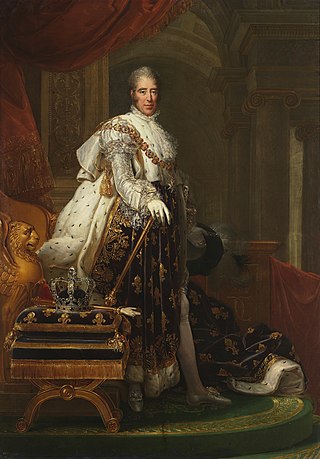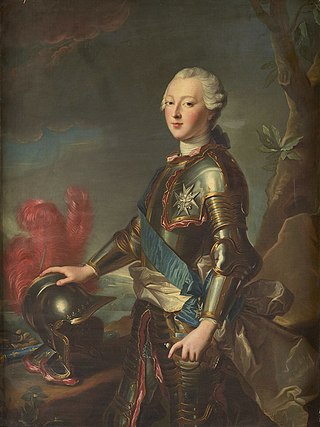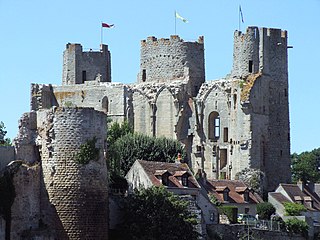Deaths
| | This section is empty. You can help by adding to it. (June 2010) |
| Years in Quebec: | 1609 1610 1611 1612 1613 1614 1615 |
| Centuries: | 16th century · 17th century · 18th century |
| Decades: | 1580s 1590s 1600s 1610s 1620s 1630s 1640s |
| Years: | 1609 1610 1611 1612 1613 1614 1615 |
Events from the year 1612 in Quebec .
| | This section is empty. You can help by adding to it. (June 2010) |

The House of Bourbon is a dynasty that originated in the Kingdom of France as a branch of the Capetian dynasty, the royal House of France. Bourbon kings first ruled France and Navarre in the 16th century. A branch descended from the French Bourbons came to rule Spain in the 18th century and is the current Spanish royal family. Further branches, descended from the Spanish Bourbons, held thrones in Naples, Sicily, and Parma. Today, Spain and Luxembourg have monarchs of the House of Bourbon. The royal Bourbons originated in 1272, when Robert, the youngest son of King Louis IX of France, married the heiress of the lordship of Bourbon. The house continued for three centuries as a cadet branch, serving as nobles under the direct Capetian and Valois kings.

Louis XVIII, known as the Desired, was King of France from 1814 to 1824, except for a brief interruption during the Hundred Days in 1815. He spent 23 years in exile from 1791: during the French Revolution and the First French Empire (1804–1814), and during the Hundred Days.

The Second Bourbon Restoration was the period of French history during which the House of Bourbon returned to power after the fall of the First French Empire in 1815. The Second Bourbon Restoration lasted until the July Revolution of 26 July 1830. Louis XVIII and Charles X, brothers of the executed King Louis XVI, successively mounted the throne and instituted a conservative government intended to restore the proprieties, if not all the institutions, of the Ancien Régime. Exiled supporters of the monarchy returned to France but were unable to reverse most of the changes made by the French Revolution. Exhausted by decades of war, the nation experienced a period of internal and external peace, stable economic prosperity and the preliminaries of industrialization.

Charles X was King of France from 16 September 1824 until 2 August 1830. An uncle of the uncrowned Louis XVII and younger brother of reigning kings Louis XVI and Louis XVIII, he supported the latter in exile. After the Bourbon Restoration in 1814, Charles became the leader of the ultra-royalists, a radical monarchist faction within the French court that affirmed absolute monarchy by divine right and opposed the constitutional monarchy concessions towards liberals and the guarantees of civil liberties granted by the Charter of 1814. Charles gained influence within the French court after the assassination of his son Charles Ferdinand, Duke of Berry, in 1820 and succeeded his brother Louis XVIII in 1824.
The Most Serene House of Bourbon-Condé, named after Condé-en-Brie, was a French princely house and a cadet branch of the House of Bourbon. The name of the house was derived from the title of Prince of Condé that was originally assumed around 1557 by the French Protestant leader Louis de Bourbon (1530–1569), uncle of King Henry IV of France, and borne by his male-line descendants.

Louis Alphonse de Bourbon is the head of the House of Bourbon. Members of the family formerly ruled France and other countries. According to the Legitimists, Louis Alphonse is heir to the defunct throne of France. Since the death of his father in 1989, he has used the courtesy title of Duke of Anjou.

The Palais Bourbon is the meeting place of the National Assembly, the lower legislative chamber of the French Parliament. It is located in the 7th arrondissement of Paris, on the Rive Gauche of the Seine, across from the Place de la Concorde.

Louis Antoine de Bourbon, Duke of Enghien was a member of the House of Bourbon of France. More famous for his death than his life, he was executed by order of Napoleon Bonaparte, who brought charges against him of aiding Britain and plotting against Napoleon.

Duke of Bourbon is a title in the peerage of France. It was created in the first half of the 14th century for the eldest son of Robert of France, Count of Clermont, and Beatrice of Burgundy, heiress of the lordship of Bourbon. In 1416, with the death of John of Valois, the Dukes of Bourbon were simultaneously Dukes of Auvergne.

Louis Henri, Duke of Bourbon, was a French nobleman and politician who served as Prime Minister of France from 1723 to 1726. As a member of the reigning House of Bourbon, he was a prince du sang.

Louis Joseph de Bourbon was Prince of Condé from 1740 to his death. A member of the House of Bourbon, he held the prestigious rank of Prince du Sang.

Louis Henri Joseph de Bourbon was the Prince of Condé from 1818 to his death. He was the brother-in-law of Philippe Égalité and nephew of Victoire de Rohan.

Bourbon-l'Archambault is a spa town and a commune in the Allier department in Auvergne-Rhône-Alpes region in central France. It is the place of origin of the House of Bourbon.

The 4th House of Orléans, sometimes called the House of Bourbon-Orléans to distinguish it, is the fourth holder of a surname previously used by several branches of the Royal House of France, all descended in the legitimate male line from the dynasty's founder, Hugh Capet. The house was founded by Philippe I, Duke of Orléans, younger son of Louis XIII and younger brother of Louis XIV, the "Sun King".

Louis Jean Marie de Bourbon was the son of Louis Alexandre de Bourbon and his wife Marie Victoire de Noailles. He was therefore a grandson of Louis XIV of France and his mistress, Madame de Montespan. From birth he was known as the Duke of Penthièvre. He also possessed the following titles: Prince of Lamballe ; Prince of Carignano; Duke of Rambouillet; Duke of Aumale (1775); Duke of Gisors; Duke of Châteauvillain; Duke of Arc-en-Barrois; Duke of Amboise; Count of Eu; Count of Guingamp. He was the father in law of Philippe Égalité.

Vallery is a commune in the Yonne department in Bourgogne-Franche-Comté in north-central France.

A prince du sang or prince of the blood is a person legitimately descended in male line from a sovereign. The female equivalent is princess of the blood, being applied to the daughter of a prince of the blood. The most prominent examples include members of the French royal line, but the term prince of the blood has been used in other families more generally, for example among the British royal family and when referring to the Shinnōke in Japan.

Marie Thérèse de Bourbon was the titular Queen consort of Poland in 1697. She was the daughter of the Prince of Condé. As a member of France's reigning House of Bourbon, she was a princesse du sang.
Events from the year 1743 in France.